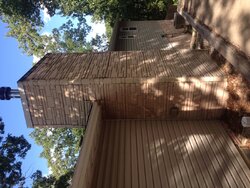- Aug 6, 2007
- 442
Hey guys. years ago I tore out my old fireplace and put in a wood burning stove. I just utilized the old chimney chase that was there and used double wall dura vent pipe in place of the old chimney pipe. It's been working fine for awhile but now, the frame and siding around the chase is deteriorating. I've been keeping up with the bandaid fixes but the time has come for a change. Originally I had decided tear off the old siding and solidify the wood frame, redo the insulation and pan on top but that was an expensive and time consuming venture only to have the end result be something I wasn't too jazzed about. So, I'm now looking into just an exposed pipe and finishing off the wall with the metal siding I've used around the basement portion of my house.
I've done some looking online and it looks like I have 2 options. 1) Thru the roof or 2) angle around or extend past the soffit/fascia/gutters. To barely clear the soffit/fascia/gutters is just under 22 inches. I've read that the extenders can be tricky but I've seen angle pipe used as well. If it was up to me I'd try and avoid going thru the roof but I'm not well versed on this so here I am with my post.
My current pipe run comes up from the stove in the living room with single wall pipe and turns to go straight thru the exterior wall thimble to a T. That T then goes straight up 13' to the cap. It's worked well for us for a long while now so I'd like to keep it that way.
Are there any drawbacks to having the pipe exposed like that? It's stainless so I don't expect rust to be an issue but since it is more exposed to the elements, and we do get high winds and ice here, is that going to affect my burns or creosote build up? I've not priced anything yet but I do want this pipe to be rock solid as I am at the top of a hill and the winds can get pretty nasty in the spring when tornado season hits.
Sorry for the long winded post but I wanted to create as clear a pic as possible.
Thanks in advance for any help you are able to provide.
I've done some looking online and it looks like I have 2 options. 1) Thru the roof or 2) angle around or extend past the soffit/fascia/gutters. To barely clear the soffit/fascia/gutters is just under 22 inches. I've read that the extenders can be tricky but I've seen angle pipe used as well. If it was up to me I'd try and avoid going thru the roof but I'm not well versed on this so here I am with my post.
My current pipe run comes up from the stove in the living room with single wall pipe and turns to go straight thru the exterior wall thimble to a T. That T then goes straight up 13' to the cap. It's worked well for us for a long while now so I'd like to keep it that way.
Are there any drawbacks to having the pipe exposed like that? It's stainless so I don't expect rust to be an issue but since it is more exposed to the elements, and we do get high winds and ice here, is that going to affect my burns or creosote build up? I've not priced anything yet but I do want this pipe to be rock solid as I am at the top of a hill and the winds can get pretty nasty in the spring when tornado season hits.
Sorry for the long winded post but I wanted to create as clear a pic as possible.
Thanks in advance for any help you are able to provide.


